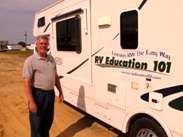We enjoy using our RV as much as possible throughout the year. But when you can’t use your RV, for whatever reasons and temperatures are approaching freezing, it’s important that you protect it. Last week I talked about preparing your RV’s interior, exterior and chassis for storage during the colder winter months. I mentioned at the beginning of the article that the RV plumbing system is the most vulnerable to damage caused by plummeting temperatures. The good news is it is really quite easy to protect the RV water system from this potential threat. I am including a checklist from my “Checklists for RVers” eBook to help walk you through the winterizing process.
Before you get started there are a few items you will need to have. These items can be found in most RV parts stores:
■ Non-toxic RV/Marine antifreeze. The amount depends on the layout and length of your plumbing lines. Two to three gallons will normally do.
■A water heater by-pass kit, if not already installed.
■ A tank wand to clean out the holding tanks, if you don’t have a built-in flushing system.
■A water pump converter kit, or tubing to connect to the inlet side of the water pump.
■ Basic hand tools to remove drain plugs.
Note: Be sure to read your owner’s manuals for unit specific winterizing guidelines. Follow the steps below that apply to your RV.
■If you have any inline water filters remove and/or bypass before starting.
■Drain the fresh water holding tank.
■Empty and flush the gray and black water holding tanks if it hasn’t already been done. If the RV doesn’t have a built-in flushing system clean the black tank out with a tank cleaning wand.
■Drain the water heater. Open the pressure relief valve and remove the drain plug.
Caution: Never drain the water heater when hot or under pressure. With no water hooked up to the RV and the water pump off, open a hot water faucet to remove any pressure on the system. Allow sufficient time for the tank to cool before draining.
■ Open all hot and cold faucets; don’t forget the toilet valve (pedal or lever) and the outside shower (if equipped).
■Locate and open the low point water drain lines.
■Use the water pump to help force most of the remaining water out of the system, but turn it off as soon as the system is drained to prevent damaging the pump.
Note: It is not necessary to get every drop of water out of the water system, but you want to get most of it out. The non-toxic RV antifreeze will prevent the small amount of remaining water from freezing.
■Recap all drains and close all faucets.
■ By-pass the water heater. If you do not have a by-pass kit installed the water heater will fill up with RV antifreeze before it goes through the water lines, wasting six or ten gallons of antifreeze.
Note: A water heater by-pass kit can save you money in two ways. It saves you from using an extra six or ten gallons of non-toxic RV antifreeze when it’s time to winterize your RV, and a bypass kit also prevents costly damage like ruptured water lines or a ruptured water heater tank. If water is left in the lines or tank they can freeze and expand, splitting the lines or tank. With a bypass kit you simply drain the water heater, put it in the by-pass mode and the antifreeze bypasses the tank and goes directly into the water lines.
■Install a water pump converter kit, or disconnect the inlet side of the water pump (the line coming from the fresh water holding tank to the pump) and connect tubing from the water pump inlet into a one gallon jug of RV antifreeze.
■ Turn the water pump on and pressurize the system. Starting with the closest faucet to the pump, slowly open the hot and then cold valves until the colored RV antifreeze appears. Replace the antifreeze container as required.
■Repeat this procedure on all faucets from the closest to the farthest away. Don’t forget the outside shower (if equipped).
■ Flush the toilet until antifreeze appears.
■Pour a cupful of antifreeze down every drain (all sinks, shower & tub drains).
■Pour some RV antifreeze in the toilet and flush into the holding tank to prevent any water in the tank from freezing.
■If your water heater has an electric heating element, turn it off. This will protect the element if the unit is plugged in (and the switch is on) while in storage.
■Make sure all faucets are closed.
■The unit is winterized.
Note: Consult your owner manuals for unit specific winterizing instructions for icemakers and washing machines.
Now, next spring when it’s time to head out in the RV you won’t have any unpleasant, not to mention costly, surprises waiting for.
For more great winterizing & storing information check out my Winterizing & Storing your RV E-book & my Winterizing & Storing your RV video
Happy Camping,
Mark J. Polk
RV Education 101
RV University
copyright 2009 by Mark Polk owner of RV Education 101







No comments:
Post a Comment